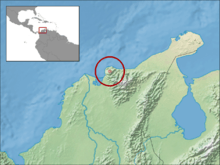Santamartamys
| Santamartamys | |
|---|---|
 | |
| A scientific illustration of Santamartamys | |
| Scientific classification | |
| Kingdom: | Animalia |
| Phylum: | Chordata |
| Class: | Mammalia |
| Order: | Rodentia |
| Family: | Echimyidae |
| Subfamily: | Echimyinae |
| Genus: | Santamartamys Emmons, 2005 |
| Species: | S. rufodorsalis |
| Binomial name | |
| Santamartamys rufodorsalis (J.A. Allen, 1899) | |
 | |
| Synonyms | |
| |
Santamartamys is a monotypic genus of rodent in family Echimyidae, containing only the red-crested tree rat (Santamartamys rufodorsalis). It is nocturnal and is believed to feed on plant matter, and is mainly rufous, with young specimens having a grey coat. IUCN list the species as critically endangered: it is affected by feral cats, climate change, and the clearing of forest in its potential range in coastal Colombia.
It is known only from three specimens, a specimen collected in 1898 in Sierra Nevada de Santa Marta and identified by Herbert Huntingdon Smith, a specimen identified by the American ornithologist and entomologist Melbourne Armstrong Carriker in 1913 at the same location, and a further specimen observed in the same location in 2011. Found at altitudes of 700 to 2,000 metres, the species is endemic to Colombia in an isolated area with high levels of biodiversity. The species was initially identified as Isothrix rufodorsalis in 1899, re-classified as Diplomys rufodorsalis in 1935, and the monotypic genus Santamartamys was created in 2005 for the species.
Discovery
On 24 December 1898, Herbert Huntingdon Smith identified the first specimen of Santamartamys in Ocana, Santa Marta, Magdalena, Colombia.[2] The specimen was of undetermined gender, and as all specimens of Smith's collections were collected by local hunters, there is no specific information regarding the location where the specimen was discovered.[2] A second specimen, also of undetermined gender, was discovered in around 1913 in the Sierra Nevada de Santa Marta by Carriker, but there is not much information regarding its location either, or the date of discovery.[2] It is assumed that the specimen was obtained through a gift or was purchased. It was recorded as a Santamartamys specimen in 1913 at the American Museum of Natural History in New York. Despite several organised searches, no other specimens were discovered.[3]
However, on 4 May 2011,[4] two volunteers from Fundación ProAves identified a young specimen in nature reserve El Dorado, Sierra Nevada de Santa Marta.[2][3] At 1,958 m (6,424 ft) above sea level, the animal was identified by five people at 11°06′02.93″N 74°04′19.36″W / 11.1008139°N 74.0720444°W, and was not intimidated by their presence.[2]
Description
Santamartamys specimens measure between 51 and 122 cm (20 and 48 in) from head to the tip of their tail, with their tails measuring between 18 and 28 cm (7.1 and 11.0 in).[5] The species can weigh up to 500 g (18 oz),[6] and has a woolly, soft, and long coat. The species is mainly rufous.[7] The hair on the dorsal region is of intense red colouring, and a large portion of the tail hair is black (basal), but the last two-fifths of the tail are white.[8] Its ears are small and light brown, and feature tufts of long hair on the inner surface, but lack hair on the outer surface. Between the eye and the ear, there is a tuft of long black hairs.[8] The thin whiskers can reach up to 13 cm (5 in) long, and has a strip of red fur around its neck.[7]
The upper surfaces of the front and rear legs are covered in a pale gray coat, and the hind legs are very short and wide.[8] The feet lack small tubercles and the thumb is covered by a nail.[7] Its skull is short and wide, and it has a heavy, large, and uncurved zygomatic bone.[8] The supraorbital ridge of the skull is large, and the interorbital region is very broad with nearly parallel sides.[8] The facial portion of the skull is very short, and the distance between the incisors and the molars is slightly less than the length of the coronary surface of its upper row of teeth.[8] Santamartamys has large eyes, which is consistent with its nocturnal behaviour.[2] It has two pairs of udders on the lateral edge of the abdominal side coat.[7]
Young specimens of Santamartamys have a grey coat.[2] During the transition to the adult intense red coat, moulting begins at the anterior region and moves backward.[2]
Behaviour, distribution and habitat
Santamartamys is a nocturnal rodent,[4] and its diet is unknown, but it is assumed to feed on plant matter such as fruits or seeds, like similar species in family Echimyidae.[9] It is able to easily climb a vertical wooden surface. The specimen observed in 2011 made no sounds.[2] It is endemic to Colombia, and has only been found in Sierra Nevada de Santa Marta at altitudes of 700 to 2,000 m (2,300 to 6,600 ft).[5] Due to the location's isolation and specific geological and climatic conditions, this mountainous region has high levels of biodiversity and endemism.[2] It is believed that the habitat of Santamartamys is suffering degradation.[1]
Classification

Known as the "red-crested tree rat",[1] this species was originally described as Isothrix rufodorsalis by American biologist Joel Asaph Allen in 1899, and was transferred to genus Diplomys in 1935 by George Henry Hamilton Tate.[10] In 2005, its subfamily Echimyinae was revised by Louise Emmons from the Smithsonian Institution, and identified a number of unique features of this species, including the differences between the teeth of this species and others in genus Diplomys.[2] This resulted in the establishment of monotypic genus Santamartamys.[2]
The genus name Santamartamys comes from "Santa Marta", part of the name of the location where the specimens were found, and mys, meaning "mouse".[7] Rufodorsalis comes from Latin, with rufus and dorsalis meaning "red" and "back", respectively, referring to the colour of this rodent.[7]
Threats and protection
Santamartamys was rediscovered on 4 May 2011 in nature reserve El Dorado, a protected area of Sierra Nevada de Santa Marta.[2] Set up on 31 March 2006, this reserve covers 1,024 ha (2,530 acres) at an altitude between 950 and 2,600 m (3,120 and 8,530 ft), and contains a large number of endemic or endangered species.[11]
In 1990, Emmons believed that Santamartamys was one of the rarest neotropical mammals.[5] The International Union for Conservation of Nature (IUCN) described the species as "Vulnerable" in 1996.[1] In 2008, two assessors from IUCN re-classified it as "Data deficient",[1] given the lack of information regarding the distribution, ecology and habitat of this rodent.[2] Following a reassessment in 2011, the species was listed as "Critically endangered", with much of the forest in the potential range of the species having been cleared or degraded.[1] Much of its potential area is infested with feral cats (who feed on fauna),[3][6] and climate change is a long-term threat to the species.[1]
See also
References
- 1 2 3 4 5 6 7 Patterson, B. & Lacher, T. 2011. Santamartamys rufodorsalis. The IUCN Red List of Threatened Species. Downloaded on 11 January 2016.
- 1 2 3 4 5 6 7 8 9 10 11 12 13 14 Noble, Elizabeth; McKeown, Simon; Sechrest, Wes (31 October 2011). Rediscovery of Santamartamys rufodorsalis (Rodent: Echimyidae). Conservación Colombiana. pp. 40–43. ISSN 1900-1592.
- 1 2 3 "Spectacular mammal rediscovered after 113 years!". IUCN. 19 May 2011. Retrieved 28 November 2014.
- 1 2 "Espectacular mamífero redescubierto después de 113 años en la Sierra Nevada de Santa Marta" (in Spanish). ProAves Colombia. 18 May 2011. Retrieved 28 November 2014.
- 1 2 3 Nowak, Ronald M. (1999). Walker's Mammals of the World. 1. JHU Press. p. 1696. ISBN 9780801857898.
- 1 2 "Rediscovered in Santa Marta - rodent that has not been seen since 1898" (in Spanish). Semana. 18 May 2011.
- 1 2 3 4 5 6 Emmons, Louise Hickock (2006). "A revision of the genera of arboreal Echimyidae (Rodentia: Echimyidae, Echimyinae), with descriptions of two new genera". Mammalian Diversification: From Chromosomes to phylogeography (A Celebration of the Career of James L. Patton). 133. University of California Press. pp. 247–310. ISBN 9780520098534.
- 1 2 3 4 5 6 Allen, Joel Asaph (1899). New Rodents from Colombia and Venezuela (PDF). 12. Bulletin of the American Museum of Natural History.
- ↑ BSi (2012), Santamartamys (Allen, 1899) (in Spanish), Sistema de información sobre biodiversidad in Colombia
- ↑ Woods, C.A.; Kilpatrick, C.W. (2005). "Infraorder Hystricognathi". In Wilson, D.E.; Reeder, D.M. Mammal Species of the World: A Taxonomic and Geographic Reference (3rd ed.). Johns Hopkins University Press. p. 1577. ISBN 978-0-8018-8221-0. OCLC 62265494.
- ↑ "Reserva Natural de las Aves El Dorado" (in Spanish). Fundación ProAves. Retrieved 28 November 2014.
